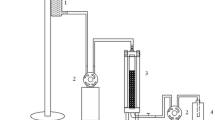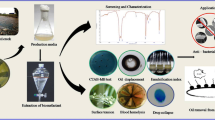Abstract
Marine crude oil spill is the most alarming environmental issue and the dreadful instance of petroleum hydrocarbon pollution around the world. Successful remediation of these toxic pollutants demands for the ample production of biosurfactant and biocatalysts by the native hydrocarbon-degrading microbes. The main focus of this investigation is to determine the potential of a halo-tolerant and biosurfactant-producing hydrocarbonoclastic bacterium, Enterobacter hormaechei, for the effective bioremediation of marine oil spill. The strain had the ability to produce biosurfactant with excellent surface and emulsification activities along with biocatalysts. The activity of the extracellular enzymes such as lipase and laccase was found to be 160 U/ml and 38 U/ml, respectively, whereas the intracellular enzymes like alkane hydroxylase, alcohol dehydrogenase and esterase showed the corresponding activities of 48 U/ml, 86 U/ml and 102 U/ml. Overall, E. hormaechei could be able to degrade nearly 85% of petroleum hydrocarbons present in crude oil within 10 days of incubation. The biosurfactant was characterized to be an anionic, high molecular weight (48 kDa) lipoprotein-type biosurfactant. The biosurfactant was further characterized by Fourier transform infrared spectroscopy. The E. hormaechei was employed for the treatment of simulated marine oil spill and the degradation followed pseudo-second-order kinetics with rate constant k2 0.2775 and R2 0.9923. The crude oil degradation was confirmed by gas chromatography–mass spectrometry. The study suggested that the E. hormaechei is a potential biosurfactant and biocatalysts producer with the effective management of accidental marine oil spills.









Similar content being viewed by others
References
Abouee Mehrizi E, Kermani M, Farzadkia M et al (2019) Study of improvement of bioremediation performance for the degradation of petroleum hydrocarbons in oily sludge by a chemical pretreatment strategy. J Mater Cycles Waste Manag 21:1052–1062. https://doi.org/10.1007/s10163-019-00848-y
Asemoloye MD, Ahmad R, Jonathan SG (2017) Synergistic action of rhizospheric fungi with Megathyrsus maximus root speeds up hydrocarbon degradation kinetics in oil polluted soil. Chemosphere 187:1–10. https://doi.org/10.1016/j.chemosphere.2017.07.158
Azin E, Moghimi H, Heidarytabar R (2018) Petroleum degradation, biosurfactant and laccase production by Fusarium neocosmosporiellum RH-10: a Microcosm study. Soil Sediment Contam 27:329–342. https://doi.org/10.1080/15320383.2018.1473334
Chen Q, Li J, Liu M et al (2017) Study on the biodegradation of crude oil by free and immobilized bacterial consortium in marine environment. PloS ONE 12:1–23. https://doi.org/10.1371/journal.pone.0174445
Colin VL, Pereira CE, Villegas LB et al (2013) Production and partial characterization of bioemulsifier from a chromium-resistant actinobacteria. Chemosphere 90:1372–1378. https://doi.org/10.1016/j.chemosphere.2012.08.002
Elumalai P, Parthipan P, Parthiba Karthikeyan O, Rajasekar A (2017) Enzyme-mediated biodegradation of long-chain n-alkanes (C32 and C40) by thermophilic bacteria. 3 Biotech 7:1–10. https://doi.org/10.1007/s13205-017-0773-y
Gurav R, Lyu H, Ma J et al (2017) Degradation of n-alkanes and PAHs from the heavy crude oil using salt-tolerant bacterial consortia and analysis of their catabolic genes. Environ Sci Pollut Res 24:11392–11403. https://doi.org/10.1007/s11356-017-8446-2
Han Y, Nambi IM, Prabhakar Clement T (2018) Environmental impacts of the Chennai oil spill accident—a case study. Sci Total Environ 626:795–806. https://doi.org/10.1016/j.scitotenv.2018.01.128
Imam A, Suman SK, Ghosh D, Kanaujia PK (2019) Analytical approaches used in monitoring the bioremediation of hydrocarbons in petroleum-contaminated soil and sludge. TrAC Trends Anal Chem 118:50–64. https://doi.org/10.1016/j.trac.2019.05.023
Jauhari N, Mishra S, Kumari B, Singh SN (2014) Bacteria-mediated aerobic degradation of hexacosane in vitro conditions. Bioresour Technol 170:62–68. https://doi.org/10.1016/j.biortech.2014.07.091
Joy S, Rahman PKSM, Sharma S (2017) Biosurfactant production and concomitant hydrocarbon degradation potentials of bacteria isolated from extreme and hydrocarbon contaminated environments. Chem Eng J 317:232–241. https://doi.org/10.1016/j.cej.2017.02.054
Kadri T, Magdouli S, Rouissi T, Brar SK (2018a) Ex-situ biodegradation of petroleum hydrocarbons using Alcanivorax borkumensis enzymes. Biochem Eng J 132:279–287. https://doi.org/10.1016/j.bej.2018.01.014
Kadri T, Rouissi T, Magdouli S et al (2018b) Production and characterization of novel hydrocarbon degrading enzymes from Alcanivorax borkumensis. Int J Biol Macromol 112:230–240. https://doi.org/10.1016/j.ijbiomac.2018.01.177
Kalcikova G, Babic J, Pavko A, Gotvajn AZ (2014) Fungal and enzymatic treatment of mature municipal landfill leachate. Waste Manag 34:798–803. https://doi.org/10.1016/j.wasman.2013.12.017
Kumari B, Singh SN, Singh DP (2016) Induced degradation of crude oil mediated by microbial augmentation and bulking agents. Int J Environ Sci Technol 13:1029–1042. https://doi.org/10.1007/s13762-016-0934-2
Laemmli UK (1970) Cleavage of structural proteins during the assembly of the head of bacteriophage T4. Nature 227:680–685. https://doi.org/10.1038/227680a0
Liu B, Liu J, Ju M et al (2017) Bacteria-white-rot fungi joint remediation of petroleum-contaminated soil based on sustained-release of laccase. RSC Adv 7:39075–39081. https://doi.org/10.1039/c7ra06962f
Meng L, Li H, Bao M, Sun P (2017) Metabolic pathway for a new strain Pseudomonas synxantha LSH-7′: from chemotaxis to uptake of n-hexadecane. Sci Rep 7:1–13. https://doi.org/10.1038/srep39068
Milic JS, Solevic TM, Beskoski VP et al (2012) Biodegradation of petroleum sludge and petroleum polluted soil by a bacterial consortium: a laboratory study. Biodegradation 23:1–14. https://doi.org/10.1007/s10532-011-9481-1
Muthukamalam S, Sivagangavathi S, Dhrishya D, Rani SS (2017) Characterization of dioxygenases and biosurfactants produced by crude oil degrading soil bacteria. Brazilian J Microbiol 48:637–647. https://doi.org/10.1016/j.bjm.2017.02.007
Nwankwegu AS, Onwosi CO, Azi F et al (2017) Use of rice husk as bulking agent in bioremediation of automobile gas oil impinged agricuktural soil. Soil Sediment Contam Int J 26:96–114. https://doi.org/10.1080/15320383.2017.1245711
Ohadi M, Dehghan-Noudeh G, Shakibaie M et al (2017) Isolation, characterization, and optimization of biosurfactant production by an oil-degrading Acinetobacter junii B6 isolated from an Iranian oil excavation site. Biocatal Agric Biotechnol 12:1–9. https://doi.org/10.1016/j.bcab.2017.08.007
Panjiar N, Sachan SG, Sachan A (2015) Screening of bioemulsifier-producing micro-organisms isolated from oil-contaminated sites. Annu Microbiol 65:753–764. https://doi.org/10.1007/s13213-014-0915-y
Pasumarthi R, Chandrasekaran S, Mutnuri S (2013) Biodegradation of crude oil by Pseudomonas aeruginosa and Escherichia fergusonii isolated from the Goan coast. Mar Pollut Bull 76:276–282. https://doi.org/10.1016/j.marpolbul.2013.08.026
Patowary K, Patowary R, Kalita MC, Deka S (2016) Development of an efficient bacterial consortium for the potential remediation of hydrocarbons from contaminated sites. Front Microbiol 7:1–14. https://doi.org/10.3389/fmicb.2016.01092
Płociniczak MP-, Płaza GA, Piotrowska-seget Z, Cameotra SS (2011) Environmental applications of biosurfactants: recent advances. Int J Mol Sci 12:633–654. https://doi.org/10.3390/ijms12010633
Qiao N, Shao Z (2010) Isolation and characterization of a novel biosurfactant produced by hydrocarbon-degrading bacterium Alcanivorax dieselolei B-5. J Appl Microbiol. https://doi.org/10.1111/j.1365-2672.2009.04513.x
Ramani K, Jain SC, Mandal AB, Sekaran G (2012) Microbial induced lipoprotein biosurfactant from slaughterhouse lipid waste and its application to the removal of metal ions from aqueous solution. Colloids Surfaces B Biointerfaces 97:254–263. https://doi.org/10.1016/j.colsurfb.2012.03.022
Ramavandi B, Ghafarizadeh F, Alavi N et al (2018) Biotreatment of total petroleum hydrocarbons from an oily sludge using co-composting approach. Soil Sediment Contam 27:524–537. https://doi.org/10.1080/15320383.2018.1489371
Salam LB, Idris H (2019) Consequences of crude oil contamination on the structure and function of autochthonous microbial community of a tropical agricultural soil. Environ Sustain 2:167–187. https://doi.org/10.1007/s42398-019-00058-0
Saranya P, Kumari HS, Jothieswari M et al (2014) Novel extremely acidic lipases produced from Bacillus species using oil substrates. J Ind Microbiol Biotechnol 41:9–15. https://doi.org/10.1007/s10295-013-1355-6
Saranya P, Bhavani P, Swarnalatha S, Sekaran G (2015) Biosequestration of chromium(III) in aqueous solution using cationic and anionic biosurfactants produced from two different Bacillus sp.—a comparative study P. RSC Adv 5:80596–80611
Sarkar J, Kazy SK, Gupta A, Dutta A, Mohapatra B, Roy A, Bera P, Mitra A, Sar P (2016) Biostimulation of indigenous microbial community for bioremediation of petroleum refinery sludge. Front Microbiol 7:1407. https://doi.org/10.3389/fmicb.2016.01407
Sekhon KK, Khanna S, Cameotra SS (2012) Biosurfactant production and potential correlation with esterase activity. J Pet Environ Biotechnol 03:1–10. https://doi.org/10.4172/2157-7463.1000133
Sekkour S, Abdelkader B, Bouchiba Z et al (2019) The diversity of cultivable hydrocarbon-degrading bacteria isolated from crude oil contaminated soil and sludge from Arzew Refinery in Algeria. J Microbiol Biotechnol Food Sci 9:70–77. https://doi.org/10.15414/jmbfs.2019.9.1.70-77
Silva RDCFS, Almeida DG, Rufino RD et al (2014) Applications of biosurfactants in the petroleum industry and the remediation of oil spills. Int J Mol Sci 15:12523–12542. https://doi.org/10.3390/ijms150712523
Suganthi SH, Murshid S, Sriram S, Ramani K (2018) Enhanced biodegradation of hydrocarbons in petroleum tank bottom oil sludge and characterization of biocatalysts and biosurfactants. J Environ Manag 220:87–95. https://doi.org/10.1016/j.jenvman.2018.04.120
Tahhan RA, Ammari TG, Goussous SJ, Al-Shdaifat HI (2011) Enhancing the biodegradation of total petroleum hydrocarbons in oily sludge by a modified bioaugmentation strategy. Int Biodeterior Biodegrad 65:130–134. https://doi.org/10.1016/j.ibiod.2010.09.007
Wang W, Cai B, Shao Z (2014) Oil degradation and biosurfactant production by the deep sea bacterium Dietzia maris As-13-3. Front Microbiol 5:1–11
Wu M, Dick WA, Li W et al (2016) Bioaugmentation and biostimulation of hydrocarbon degradation and the microbial community in a petroleum-contaminated soil. Int Biodeterior Biodegradation 107:158–164. https://doi.org/10.1016/j.ibiod.2015.11.019
Xu X, Liu W, Tian S et al (2018) Petroleum hydrocarbon-degrading bacteria for the remediation of oil pollution under aerobic conditions: a perspective analysis. Front Microbiol 9:1–11. https://doi.org/10.3389/fmicb.2018.02885
Yanto DHY, Tachibana S (2014) Potential of fungal co-culturing for accelerated biodegradation of petroleum hydrocarbons in soil. Elsevier, Amsterdam
Zhang Z, Hou Z, Yang C et al (2011) Degradation of n-alkanes and polycyclic aromatic hydrocarbons in petroleum by a newly isolated Pseudomonas aeruginosa DQ8. Bioresour Technol 102:4111–4116. https://doi.org/10.1016/j.biortech.2010.12.064
Zhang J, Xue Q, Gao H et al (2016) Production of lipopeptide biosurfactants by Bacillus atrophaeus 5-2a and their potential use in microbial enhanced oil recovery. Microb Cell Fact 15:1–11. https://doi.org/10.1186/s12934-016-0574-8
Zheng C, Li Z, Su J et al (2012) Characterization and emulsifying property of a novel bioemulsifier by Aeribacillus pallidus YM-1. J Appl Microbiol 113:44–51. https://doi.org/10.1111/j.1365-2672.2012.05313.x
Acknowledgement
The authors are grateful to the Department of Biotechnology, Ministry of Science and Technology, New Delhi, for sanctioning the project (BT/PR20297/BBE/117/193/2016) under “Biosystems and Bioprocess Engineering scheme”. We are also extending our acknowledgment to SRM-DBT Partnership Platform for Contemporary Research Services and Skill Development in Advanced Life Sciences Technologies and Department of Biotechnology, School of Bioengineering, SRMIST (No. BT/PR12987/INF/22/205/2015), for providing instrumental facilities.
Author information
Authors and Affiliations
Corresponding author
Ethics declarations
Ethical approval
The research does not involve human volunteers or animals for any experiments conducted by any of the authors.
Additional information
Editorial responsibility: Xu Han.
Electronic supplementary material
Below is the link to the electronic supplementary material.
Rights and permissions
About this article
Cite this article
Muneeswari, R., Swathi, K.V., Sekaran, G. et al. Microbial-induced biosurfactant-mediated biocatalytic approach for the bioremediation of simulated marine oil spill. Int. J. Environ. Sci. Technol. 19, 341–354 (2022). https://doi.org/10.1007/s13762-020-03086-0
Received:
Revised:
Accepted:
Published:
Issue Date:
DOI: https://doi.org/10.1007/s13762-020-03086-0




